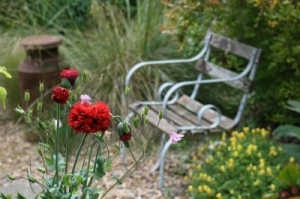home
All about window dressing
I’m going to tell you a little secret now. A good friend of mine has a Victorian house, beautifully restored, but not a single curtain in the whole place. It’s drafty, noisy and echoey, but I am too polite to tell her. Life doesn’t have to be like that, even if you are on a budget. If you want to dress your windows attractively, but at minimal cost, there are a few austerity secrets you can bear in mind. Downstairs, it makes sense to have a translucent white blind at each window, and upstairs, a white black out blind, as these are comparatively cheap to acquire, especially if you are able to brandish a pair of scissors and a hacksaw and trim them to size yourself. They can then be pulled for privacy or to keep the heat of the day out in summer, protecting your fabrics, plus they also look quite sophisticated. If you would like to have curtains in addition to these, which is a good idea if you also want to insulate your house well in winter, they are fairly easy to make and advice is readily found in sewing books or from any of the older ladies still populating the haberdashery departments of large stores. In terms of buying the fabric, allow roughly twice the width of the window, and the length plus 20cm, and you won’t go too far wrong (retailers can always help you calculate what is needed if you ask nicely). If you are daunted by the thought of making your own curtains, there is a cunning plan you can adopt. Buy ready made cream calico ones with tab tops and stitch a panel of the most gorgeous fabric you can bear to buy onto the front, so it co-ordinates with your room, or sew it on as a square panel and then use decorative metal clips to attach it to curtain rings. Remember you can also use door curtains to reduce heat loss if necessary, and this will also help you reduce energy consumption. These can be mounted on special rails so they open with the door, and large department stores once again will be able to sell you these. There seems to be a curtain technology for everything. Long live curtains!
Image: goldsaint / FreeDigitalPhotos.net
The joy of flooring
What you put on your floors varies according to personal preference, but there are some useful things to be remembered when choosing what to do. Flats on upper floors should have carpet, otherwise you are being very mean to your neighbours below (carpet is even specified in many leases, precisely for this reason). If you have allergies, it is often possible to have carpet if you want it, as long as you buy a top quality Allergy Foundation approved hoover with a special filter (usually known as a HEPA filter) and use it frequently. You will need to put down rugs in areas of particular wear and tear, in order to avoid re-carpeting every few years. Annual use of a wet/dry vacuum cleaner can help remove deeply ingrained dirt from the fibres and ensure your carpet lasts a great deal longer as well, plus it can be extremely satisfying to see how much truly yucky stuff can be extracted from them (you may well laugh, but we all do it). If you prefer laminate flooring, consider whether it will seem cold and unwelcoming in the winter. If so, try rugs, but make sure they have non-slip webbing placed underneath. Real wood flooring can be off the scale of stylish, but extremely expensive. If you have inherited it, make sure people remove stiletto shoes when coming through the door (not like one of our friends, who inadvertently gave our innocent cherrywood floor a ‘distressed’ finish with her heels. We have just about forgiven her, but only just. The floor hasn’t, though). Ceramic flooring benefits from having heating installed underneath it, but again, may be too expensive to consider compared to putting down a decent piece of linoleum in kitchens and bathrooms.
Image: seaskylab / FreeDigitalPhotos.net
Refinements in the home
If there’s one thing wrong with the 21st century, it’s that we have forgotten our design heritage and we have no discipline of ornament. No, really. We think we can just pepper our houses with all sorts of twiggy pebbly pongy nonsense, and our lives will be all the better for it. But they won’t. It just makes more dusting. Here’s some tactics for supressing your inner tat collector and moving your design radar up a level.
Art and pictures – Believe me, if you hang a few larger pictures or prints, it will look better than lots of itty bitty ones scattered around the walls, unless the smaller ones are grouped into a specific shape to make an impact. Have you got various sugar paper creations lovingly crafted by your offspring, flapping away every time someone opens the back door? Shame on you, as if it’s good enough to keep, it deserves to be displayed respectfully. Hence children’s artwork looks good in large clip frames or wooden photo frames from supermarkets, and this can be a revolving display with some of the pictures being changed regularly as the child becomes more proficient (You can live in hope. My mother was never able to experience that as my artistic capabilities are somewhat limited). Other ideas for wall displays include pieces of particularly attractive wallpaper framed under glass, antique or vintage textiles in box frames, and things you have made yourself. Remember what Ruskin said, in that everything in your house should be beautiful or useful. Listen to him. He spawned an artistic and philosophical revolution, whereas today’s glossy home and garden mags haven’t.
Ornaments – These will probably have special meaning for you (I am being charitable), and you will have collected them over time, but beware of having them scattered all over the place as they become difficult to dust and get in the way of using furniture for its proper purpose, such as putting down a cup of tea and a magazine on a side table. If you have a copious collection of little china or fluffy ornaments <groan>, for example, consider displaying these in large glass jars and they might even take on a veneer of kitsch sophistication. As with little pictures, things like this often look better grouped in some way. In terms of cleaning, a soft, clean blusher brush is absolutely ideal for dealing with most small objects, which is a favourite National Trust housekeeper’s trick, so even though your plastic piglets cost about 50p each, you now know how to treat them as though they were priceless artefacts.
Image: dan / FreeDigitalPhotos.net
Warmer house, lower fuel bills
We’re lucky to have had a pretty mild winter so far. But things are on the turn. Fuel poverty is a nasty reality of the country’s economy for many families, and we’re expecting snow as well, just to make this worse. So this weekend might be a good time to carry out an audit of your home to make sure that you have done everything possible to make it snug and cosy as winter draws in. Avoid having to stoop to spending your days swathed in a Slanket.
1. Make sure every window has curtains, preferably with a fleecy interlining. Although floor length curtains look stylish, they often block heat from getting into the room from radiators, so choose curtains that finish above radiator level if fuel economy is an issue for you.
2. Use draft excluder on doors and windows – this is very cheap and can be bought in strips to be nailed on wherever there are drafts.
3. Use temporary double glazing on your windows – this is a type of cling film that is fixed with double-sided tape and then shrunk to fit with a hairdryer. It can be removed in the spring if necessary.
4. Make heat deflectors for behind your radiators by covering pieces of board with foil and sliding them down the back.
5. Fix shelves above your radiators to deflect the heat into the room rather than letting it travel up to the ceiling.
6. Cover your letterbox with a flap so you don’t heat the street.
7. Use door curtains to stop heat escaping to hallways.
8. Consider keeping one room super cosy and pleasant and gathering there when it’s really cold.
9. Use cheap £5/£10 duvets as mattress toppers.
10. Make sure the oven is full whenever you use it, so you are cooking 2-3 days’ worth of meals at once and then reheating them quickly and cheaply in the microwave when you need them.
Image: dan / FreeDigitalPhotos.net
Doing your own survey
If you are investing a lot of money in a house, it makes sense to engage a professional surveyor to make sure everything is in order structurally. But this will only come at a later stage in the buying process when you have put in an offer on a house. In the meantime you should take trouble to examine the condition of the houses or flats you are inspecting, to minimise the risk of the surveyor finding nasty surprises and you having to call the sale off whilst still having to pay your surveyor anyway. If you are renting, the same applies apart from the fact that you will be more concerned about whether the house will be comfortable to live in than whether it is likely to fall down at the first puff of wind. Look for the following commonsense issues as you go around (we are into checklist territory here once again):
- Do the windows fit well, or do they rattle or have draughts coming through? Can you open them easily, to air the house?
- Are there any cracks in the wall big enough for you to put your finger into? If so, there may be a subsidence problem.
- Are there any damp patches in the upper parts of the walls? If so, there may be a problem with the roof or the guttering.
- What state does the plumbing and wiring seem to be in, as far as you can tell? Dark sooty patches around sockets or light fittings are a giveaway that all is not well with the electrics, and funny smells indicate drainage problems.
- Ask about whether the house has cavity wall insulation and whether there are any other energy saving measures in place.
- You should also check older properties have what is known as a damp proof course, or a layer of waterproof membrane a couple of bricks up from the ground (you can usually see evidence of this from outside with the naked eye). If things have been built on breaching the damp proof course, or there is a lot of soil in the form of a flowerbed pressed up against the wall, then the property might have potential problems. Check whether you can smell damp, as this is also a giveaway.
- How recently was the boiler serviced, and is it likely to need expensive repairs in the near future? What will it cost to heat the home? If you are going to have to rely on storage heaters, you will need to cost their use particularly carefully, for example.
- Do the neighbours seem friendly and compatible? There is no worse fate than to live underneath a party animal when you need your sleep, or next to someone wanting peace and quiet when you have three under fives.
Image: Simon Howden / FreeDigitalPhotos.net






